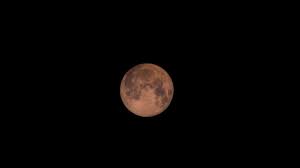The mesmerizing phenomenon of a blood moon captivates skywatchers around the world with its eerie reddish hue. But how exactly does the moon acquire this striking color during a total lunar eclipse? Let’s delve into the science behind the enigmatic blood moon and unravel the mystery of its captivating appearance.
A blood moon, also known as a total lunar eclipse, occurs when the Earth aligns perfectly between the sun and the moon, casting a shadow on the lunar surface. As the moon moves into the Earth’s shadow, it doesn’t go completely dark but instead takes on a reddish or coppery glow. This stunning transformation is a result of sunlight bending and filtering through the Earth’s atmosphere before reaching the moon.
The Earth’s atmosphere acts like a giant lens, refracting and scattering sunlight in different wavelengths. When the sun’s rays pass through the atmosphere, shorter blue and green wavelengths are scattered by the nitrogen and oxygen molecules, leaving behind the longer red wavelengths to make their way to the moon.
This process, known as Rayleigh scattering, is the same reason why our sky appears blue during the day and why sunsets radiate in shades of red and orange. The Earth’s atmosphere filters out the shorter wavelengths of light, allowing the longer, redder wavelengths to dominate the color spectrum.
During a total lunar eclipse, the red light that reaches the moon is essentially sunlight that has traveled through the Earth’s atmosphere and been bent towards the lunar surface. This reddish light then illuminates the moon, giving it the appearance of a blood moon.
The intensity of the red color can vary from eclipse to eclipse, depending on atmospheric conditions such as pollution, dust, and clouds. A particularly hazy or dusty atmosphere can scatter more light and produce a darker, more vivid red hue on the moon.
In addition to its stunning visual appeal, the blood moon holds cultural and symbolic significance in various traditions and folklore around the world. Some ancient civilizations believed that lunar eclipses were omens of impending doom or a cosmic battle between celestial forces. Today, the blood moon remains a source of fascination and wonder, drawing crowds of eager spectators to witness its otherworldly beauty.
Whether you observe the blood moon for its scientific marvel or its mystical allure, one thing is certain: this celestial event never fails to leave a lasting impression on those who gaze up at the night sky. So next time a total lunar eclipse graces the heavens, take a moment to marvel at the captivating sight of the blood moon and ponder the mysteries of the cosmos.

